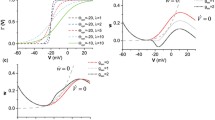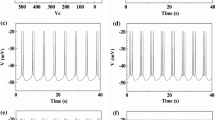Abstract
Bifurcations and enhancement of neuronal firing induced by negative feedback from an inhibitory autapse are investigated. A slow inhibitory autapse model that can exhibit dynamics similar to the inhibitory autapse of a rat interneuron is considered. Compared with a Morris–Lecar (ML) model without an autapse, enlargement of the parameter region of firing activities in the ML model with a slow inhibitory autapse can be identified with 1-parameter and 2-parameter bifurcations and is induced by a shift of an inverse Hopf bifurcation point. The right shift of the inverse Hopf bifurcation point from firing to resting state with a high membrane potential level causes the resting state in the ML model without an autapse to change to firing in the ML model with an autapse. This shows that the autapse can enhance neuronal firing and can be well interpreted by the dynamic responses of the resting state to inhibitory impulse current. In addition, many complex dynamics such as coexisting behaviors and codimension-2 bifurcations are also induced, and the relationship between the inverse Hopf bifurcation point and a physiological concept, depolarization block, a phenomenon in which a neuron enters from firing to resting state when it receives excessive excitatory or depolarizing current, is discussed. The results provide a novel viewpoint that the inhibitory autapse enhances rather than suppresses neuronal firing near the inverse Hopf bifurcation point, which is an important example showing that negative feedback can play a positive role in nonlinear dynamics.






Similar content being viewed by others
References
Izhikevich, E.M.: Neural excitability, spiking and bursting. Int. J. Bifurc. Chaos 10, 1171–1266 (2002)
Izhikevich, E.M.: Dynamical Systems in Neuroscience: The Geometry of Excitability and Bursting. MIT Press, Cambridge (2007)
Gu, H.G., Pan, B.B., Chen, G.R., Duan, L.X.: Biological experimental demonstration of bifurcations from bursting to spiking predicted by theoretical models. Nonlinear Dyn. 78, 391–407 (2014)
Gu, H.G.: Different bifurcation scenarios of neural firing patterns observed in the biological experiment on identical pacemakers. Int. J. Bifurc. Chaos 23, 1350195 (2013)
Gu, H.G.: Experimental observation of transition from chaotic bursting to chaotic spiking in a neural pacemaker. Chaos 23, 023126 (2013)
Gu, H.G., Pan, B.B.: A four-dimensional neuronal model to describe the complex nonlinear dynamics observed in the firing patterns of a sciatic nerve chronic constriction injury model. Nonlinear Dyn. 81, 2107–2126 (2015)
Gu, H.G.: Biological experimental observations of an unnoticed chaos as simulated by the Hindmarsh–Rose model. PLoS One 8, e81759 (2013)
Gu, H.G., Pan, B.B.: Identification of neural firing patterns, frequency and temporal coding mechanisms in individual aortic baroreceptors. Front. Comput. Neurosci. 9, 108 (2015)
Finke, C., Freund, J.A., Rosa Jr., E., Braun, H.A., Feudel, U.: On the role of subthreshold currents in the Huber–Braun cold receptor model. Chaos 20, 045107 (2010)
Vreeswijk, C.V., Abbott, L.F., Ermentrout, G.B.: When inhibition not excitation synchronizes neural firing. J. Comput. Neurosci. 1, 313–321 (1994)
Pfeuty, B., Mato, G., Golomb, D., Hansel, D.: Electrical synapses and synchrony: the role of intrinsic currents. J. Neurosci. 23, 6280–6294 (2003)
Pfeuty, B., Mato, G., Golomb, D., Hansel, D.: The combined effects of inhibitory and electrical synapses in synchrony. Neural Comput. 17, 633–670 (2005)
Hansel, D., Mato, G., Meunier, C.: Synchrony in excitatory neural networks. Neural Comput. 7, 307–337 (1995)
Ernst, U., Pawelzik, K., Geisel, T.: Synchronization induced by temporal delays in pulse-coupled oscillators. Phys. Rev. Lett. 74, 1570–1573 (1995)
Wang, X.J., Buzsáki, G.: Gamma oscillation by synaptic inhibition in a hippocampal interneuronal network model. J. Neurosci. 16, 6402–6413 (1996)
Bartos, M., Vida, I., Frotscher, M., Meyer, A., Monyer, H., Geiger, J.R.P., Jonas, P.: Fast synaptic inhibition promotes synchronized gamma oscillations in hippocampal interneuron networks. Proc. Natl. Acad. Sci. USA 99, 13222–13227 (2002)
Yilmaz, E., Baysal, V., Perc, M., Ozer, M.: Enhancement of pacemaker induced stochastic resonance by an autapse in a scale-free neuronal network. Sci. China Technol. Sci. 59, 364–370 (2016)
Song, X.L., Wang, C.N., Ma, J., Tang, J.: Transition of electric activity of neurons induced by chemical and electric autapses. Sci. China Technol. Sci. 58, 1007–1014 (2015)
Qin, H.X., Ma, J., Wang, C.N., Wu, Y.: Autapse-induced spiral wave in network of neurons under noise. PLoS One 9, e100849 (2014)
Connelly, W.M.: Autaptic connections and synaptic depression constrain and promote gamma oscillations. PLoS One 9, e89995 (2014)
Wu, Y.N., Gong, Y.B., Wang, Q.: Autaptic activity-induced synchronization transitions in Newman–Watts network of Hodgkin–Huxley neurons. Chaos 25, 043113 (2015)
Wang, X.J., Rinzel, J.: Alternating and synchronous rhythms in reciprocally inhibitory model neurons. Neural Comput. 4, 84–97 (1992)
Zhao, Z.G., Gu, H.G.: The influence of single neuron dynamics and network topology on time delay-induced multiple synchronous behaviors in inhibitory coupled network. Chaos Solitons Fractals 80, 96–108 (2015)
Gu, H.G., Zhao, Z.G.: Dynamics of time delay-induced multiple synchronous behaviors in inhibitory coupled neurons. PLoS One 10, 0138593 (2015)
Loos, H.V.D., Glaser, E.M.: Autapses in neocortex cerebri: synapses between a pyramidal cells axon and its own dendrites. Brain Res. 48, 355–360 (1972)
Wang, H.T., Ma, J., Chen, Y.L., Chen, Y.: Effect of an autapse on the firing pattern transition in a bursting neuron. Commun. Nonlinear Sci. Numer. Simul. 19, 3242–3254 (2014)
Wang, H.T., Wang, L.F., Chen, Y.L., Chen, Y.: Effect of autaptic activity on the response of a Hodgkin–Huxley neuron. Chaos 24, 033122 (2014)
Hashemi, M., Valizadeh, A., Azizi, Y.: Effect of duration of synaptic activity on spike rate of a Hodgkin-Huxley neuron with delayed feedback. Phys. Rev. E 85, 021917 (2012)
Wang, L., Zeng, Y.J.: Control of bursting behavior in neurons by autaptic modulation. Neurol. Sci. 34, 1977–1984 (2013)
Yilmaz, E., Baysal, V., Ozer, M., Perc, M.: Autaptic pacemaker mediated propagation of weak rhythmic activity across small-world neuronal networks. Physica A 444, 538–546 (2016)
Saada, R., Miller, N., Hurwitz, I., Susswein, A.J.: Autaptic excitation elicits persistent activity and a plateau potential in a neuron of known behavioral function. Curr. Biol. 19, 479–684 (2009)
Bacci, A., Huguenard, J.R., Prince, D.A.: Functional autaptic neurotransmission in fast-spiking interneurons: a novel form of feedback inhibition in the neocortex. J. Neurosci. 23, 859–866 (2003)
Bacci, A., Huguenard, J.R.: Enhancement of spike-timing precision by autaptic transmission in neocortical inhibitory interneurons. Neuron 49, 119–130 (2006)
Bacci, A., Huguenard, J.R., Prince, D.A.: Modulation of neocortical interneurons: extrinsic influences and exercises in self-control. Trends Neurosci. 28, 602–610 (2005)
Cobb, S.R., Halasy, K., Vida, I., NyiRi, G., Tamás, G., Buhl, E.H., Somogyi, P.: Synaptic effects of identified interneurons innervating both interneurons and pyramidal cells in the rat hippocampus. Neuroscience 79, 629–648 (1997)
Tamás, G., Buhl, E.H., Somogyi, P.: Massive autaptic self-innervation of GABAergic neurons in cat visual cortex. J. Neurosci. 17, 6352–6364 (1997)
Pouzat, C., Marty, A.: Autaptic inhibitory currents recorded from interneurons in rat cerebellar slices. J. Physiol. 509, 777–783 (1998)
Tateno, T., Pakdaman, K.: Random dynamics of the Morris–Lecar neural model. Chaos 14, 511–530 (2004)
Jalil, S., Belykh, I., Shilnikov, A.: Spikes matter for phase-locked bursting in inhibitory neurons. Phys. Rev. E 85, 036214 (2012)
Somers, D., Kopell, N.: Rapid synchronization through fast threshold modulation. Biol. Cybern. 68, 393–407 (1993)
Cymbalyuk, G.S., Gaudry, Q., Masino, M.A., Calabrese, R.L.: Bursting in leech heart interneurons: cell-autonomous and network-based mechanisms. J. Neurosci. 22, 10580–10592 (2002)
Ermentrout, B.: Simulating, Analyzing, and Animating Dynamical Systems: A Guide to XPPAUT for Researchers and Students. SIAM, Philadelphia (2002)
Dhooge, A., Govaerts, W., Kuznetsov, Y.A.: MATCONT: a MATLAB package for numerical bifurcation analysis of ODEs. ACM Trans. Math. Softw. 29, 141–164 (2003)
Heyward, P., Ennis, M., Keller, A., Shipley, M.T.: Membrane bistability in olfactory bulb mitral cells. J. Neurosci. 21, 5311–5320 (2001)
Anderson, J., Lampl, I., Reichova, I., Carandini, M., Ferster, D.: Stimulus dependence of two-state fluctuations of membrane potential in cat visual cortex. Nat. Neurosci. 3, 617–621 (2000)
Marder, E., Abbott, L.F., Turrigiano, G.G., Liu, Z., Golowasch, J.: Memory from the dynamics of intrinsic membrane currents. Proc. Natl. Acad. Sci. USA 93, 13481–13486 (1996)
Wang, W., Nakadate, K., Masugi-Tokita, M., Shutoh, F., Aziz, W., Tarusawa, E., Lorincz, A., Molnár, E., Kesaf, S., Li, Y.Q.: Distinct cerebellar engrams in short-term and long-term motor learning. Proc. Natl. Acad. Sci. USA 111, E188–E193 (2014)
Dovzhenok, A., Kuznetsov, A.S.: Exploring neuronal bistability at the depolarization block. PLoS One 7, e42811 (2012)
Hubel, N., Scholl, E., Dahlem, M.A.: Bistable dynamics underlying excitability of ion homeostasis in neuron models. PLoS Comput. Biol. 10, e1003551 (2014)
Le, T., Verley, D.R., Goaillard, J.M., Messinger, D.I., Christie, A.E., Birmingham, J.T.: Bistable behavior originating in the axon of a crustacean motor neuron. J. Neurophysiol. 95, 1356–1368 (2006)
Lee, R.H., Heckman, C.J.: Influence of voltage-sensitive dendritic conductances on bistable firing and effective synaptic current in cat spinal motoneurons in vivo. J. Neurophysiol. 76, 2107–2110 (1996)
Grace, A.A., Bunney, B.S., Moore, H., Todd, C.L.: Dopamine-cell depolarization block as a model for the therapeutic actions of antipsychotic drugs. Trends Neurosci. 20, 31–37 (1997)
Valenti, O., Cifelli, P., Gill, K.M., Grace, A.A.: Antipsychotic drugs rapidly induce dopamine neuron depolarization block in a developmental rat model of schizophrenia. J. Neurosci. 31, 12330–12338 (2011)
Pietrobon, D., Moskowitz, M.A.: Chaos and commotion in the wake of cortical spreading depression and spreading depolarizations. Nat. Rev. Neurosci. 15, 379–393 (2014)
Houssaini, K.E.I., Ivanov, A.I., Bernard, C., Jirsa, V.K.: Seizures, refractory status epilepticus, and depolarization block as endogenous brain activities. Phys. Rev. E. 91, 010701 (2015)
Bianchi, D., Marasco, A., Limongiello, A., Marchetti, C., Marie, H., Tirozzi, B., Migliore, M.: On the mechanisms underlying the depolarization block in the spiking dynamics of CA1 pyramidal neurons. J. Comput. Neurosci. 33, 207–225 (2012)
Author information
Authors and Affiliations
Corresponding author
Additional information
This work was supported by the National Natural Science Foundation of China under Grant Nos. 11572225, 11402055, and 11372224.
Rights and permissions
About this article
Cite this article
Zhao, Z., Jia, B. & Gu, H. Bifurcations and enhancement of neuronal firing induced by negative feedback. Nonlinear Dyn 86, 1549–1560 (2016). https://doi.org/10.1007/s11071-016-2976-x
Received:
Accepted:
Published:
Issue Date:
DOI: https://doi.org/10.1007/s11071-016-2976-x




